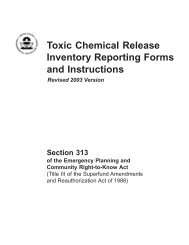Preventing Mold-Related Problems in the Indoor Workplace - Seton ...
Preventing Mold-Related Problems in the Indoor Workplace - Seton ...
Preventing Mold-Related Problems in the Indoor Workplace - Seton ...
Create successful ePaper yourself
Turn your PDF publications into a flip-book with our unique Google optimized e-Paper software.
Overview<br />
<strong>Mold</strong><br />
<strong>Mold</strong>s are <strong>the</strong> most common forms of fungi found on <strong>the</strong> earth.<br />
Fungi are classified as nei<strong>the</strong>r plants nor animals, and <strong>in</strong>clude<br />
yeasts, mildews, puffballs, and mushrooms (2). Most molds reproduce<br />
through <strong>the</strong> formation of spores, t<strong>in</strong>y microscopic cells that<br />
float through <strong>the</strong> <strong>in</strong>door and outdoor air on a cont<strong>in</strong>ual basis (3).<br />
We are all exposed to mold spores <strong>in</strong> <strong>the</strong> air we brea<strong>the</strong> on a daily<br />
basis, both <strong>in</strong>doors and outdoors. When mold spores land on a<br />
moist surface <strong>in</strong>doors, <strong>the</strong>y may beg<strong>in</strong> to grow and digest <strong>the</strong><br />
surface. Left unchecked, molds can eventually destroy <strong>the</strong> surfaces<br />
<strong>the</strong>y grow on (3). <strong>Mold</strong>s can be any color.<br />
<strong>Mold</strong>s, <strong>the</strong>ir fragments, and metabolic by-products have been<br />
associated with adverse health effects. Some diseases are known to<br />
be caused by specific molds. However, <strong>in</strong> many occupational<br />
sett<strong>in</strong>gs health conditions suspected to be mold-related cannot be<br />
l<strong>in</strong>ked to a specific mold as <strong>the</strong> only possible cause. In a wellknown<br />
case an <strong>in</strong>itial f<strong>in</strong>d<strong>in</strong>g that Stachybotrys chartarum (also<br />
known as S. atra) was l<strong>in</strong>ked to acute pulmonary hemorrhage/<br />
hemosiderosis <strong>in</strong> <strong>in</strong>fants liv<strong>in</strong>g <strong>in</strong> a water-damaged environment <strong>in</strong><br />
Cleveland, Ohio was subsequently disproved (4).<br />
Where molds are found<br />
<strong>Mold</strong>s are found almost everywhere <strong>in</strong> our environment, both<br />
outdoors and <strong>in</strong>doors. Their spores float cont<strong>in</strong>ually <strong>in</strong> <strong>the</strong> air we<br />
brea<strong>the</strong>. <strong>Mold</strong>s can grow on just about any substance, as long as<br />
moisture and oxygen are available. <strong>Mold</strong> growth may occur when<br />
excessive moisture accumulates <strong>in</strong> build<strong>in</strong>gs or on build<strong>in</strong>g materials<br />
<strong>in</strong>clud<strong>in</strong>g carpet, ceil<strong>in</strong>g tile, <strong>in</strong>sulation, paper, wallboard,<br />
wood, surfaces beh<strong>in</strong>d wallpaper, or <strong>in</strong> heat<strong>in</strong>g, ventilation, and air<br />
condition<strong>in</strong>g (HVAC) systems (3, 5).<br />
The causes of molds <strong>in</strong> build<strong>in</strong>gs<br />
It is impossible to elim<strong>in</strong>ate all molds and mold spores <strong>in</strong><br />
<strong>the</strong> <strong>in</strong>door environment. However, moisture control is <strong>the</strong> most<br />
important strategy for reduc<strong>in</strong>g <strong>in</strong>door mold growth.<br />
6
















